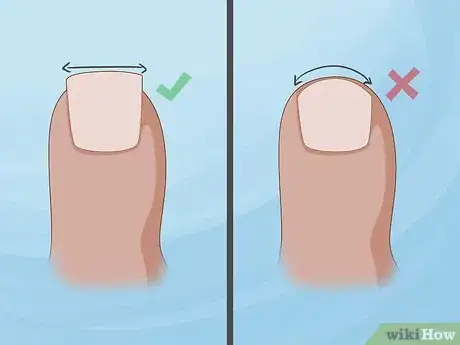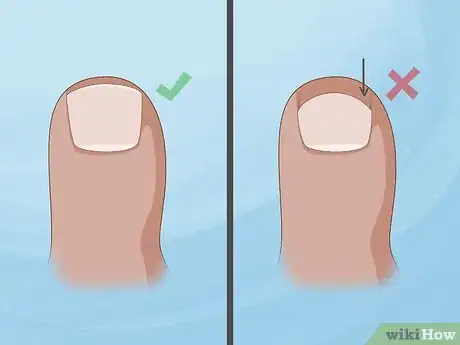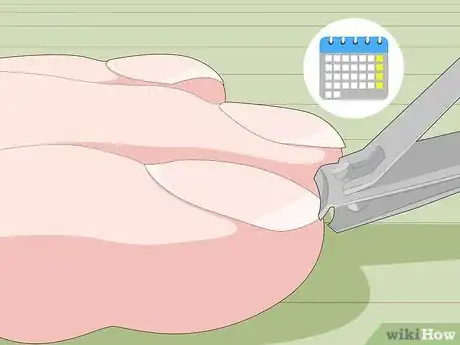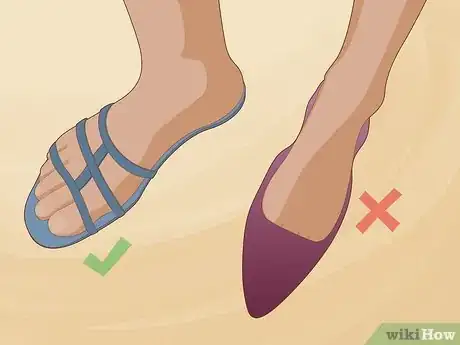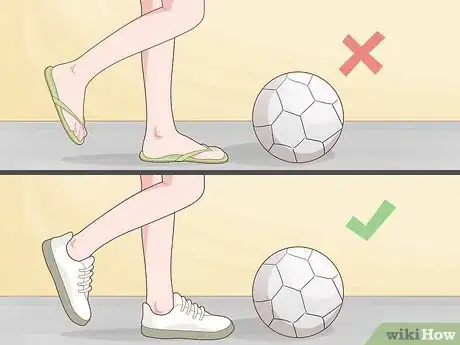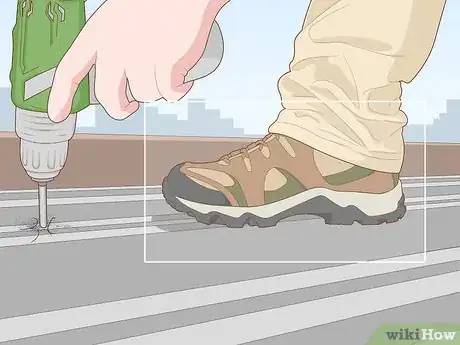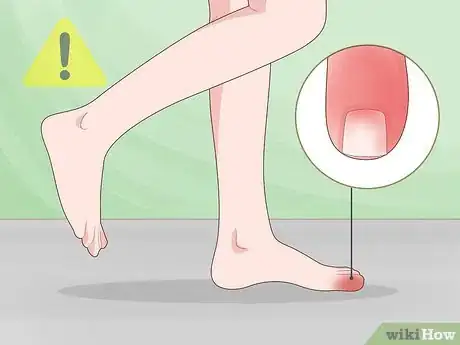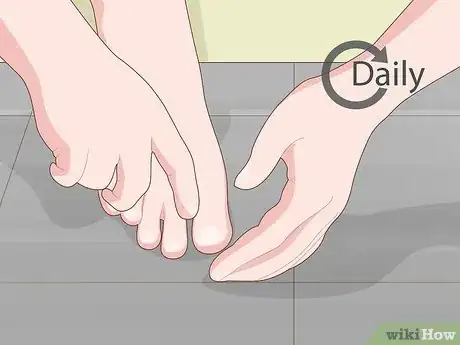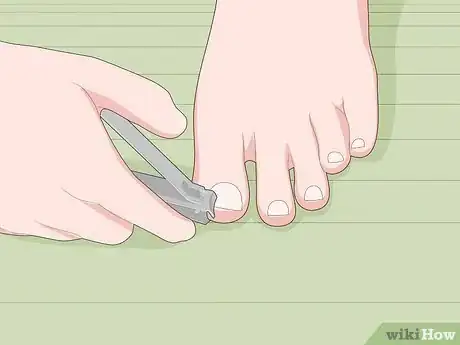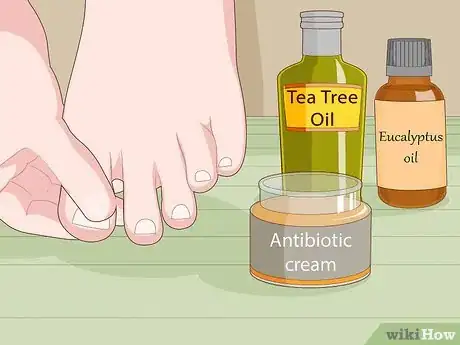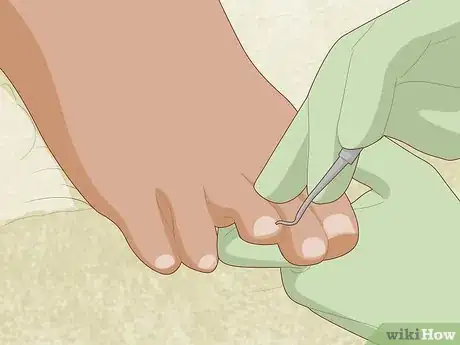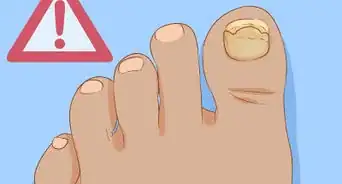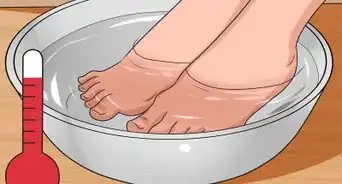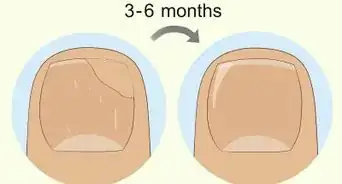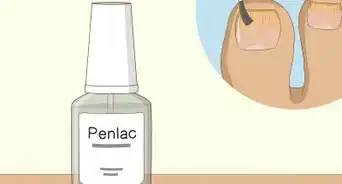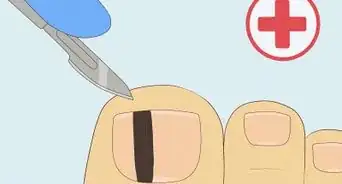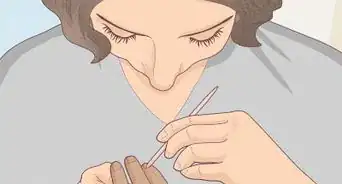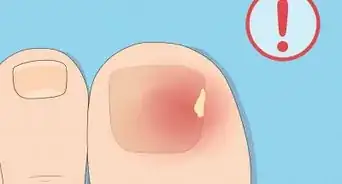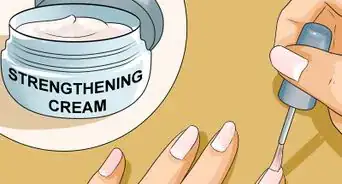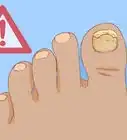This article was medically reviewed by Luba Lee, FNP-BC, MS and by wikiHow staff writer, Hannah Madden. Luba Lee, FNP-BC is a Board-Certified Family Nurse Practitioner (FNP) and educator in Tennessee with over a decade of clinical experience. Luba has certifications in Pediatric Advanced Life Support (PALS), Emergency Medicine, Advanced Cardiac Life Support (ACLS), Team Building, and Critical Care Nursing. She received her Master of Science in Nursing (MSN) from the University of Tennessee in 2006.
This article has been viewed 12,300 times.
Ingrown nails are a painful, irritating condition where the side of your nail grows into the soft skin of your toe. Ingrown toenails can cause a lot of discomfort, so it's best to prevent them before they even start. Make sure you cut your nails straight across, protect your feet while playing sports, and wear shoes that fit you well. If you have an ingrown toenail that you need to treat, try soaking it in Epsom salt and water, cutting it back yourself, and applying an antibiotic cream to prevent infection.
Steps
Cutting Your Nails Correctly
-
1Cut your nails straight across. When you cut your nails at an angle, you create more chances for a sharp edge to dig into your flesh. Use nail clippers that cut in an even, straight line. Hold your clippers upright and keep them parallel to your toe as you cut. Pay special attention to the corners of your toes so that you don’t cut them at an angle.[1]
Tip: Make sure your nail clippers are sharp enough to cut your nails the first time. If you have to pull or rip at your nails, it may be time to get new clippers.
-
2Avoid cutting your nails too short. The most common cause of ingrown nails is cutting your nails too short. Try not to cut below the white tip of your nails. If you expose the soft, pink skin underneath your nails, you’ve cut too far.[2]
- If you get manicures or pedicures, make sure the technician knows not to cut your nails too short.
Advertisement -
3Cut your nails more often if they curve naturally. If you get a lot of ingrown toenails, it may be because your nails naturally grow in a curved fashion. Keep an eye on your nails and make sure that they are growing in a straight line after you cut them. Cut them back more often if you need to correct a curve.[3]
- If anyone in your family has a history of ingrown toenails, curved toenails may run in your family.
Protecting Your Toes
-
1Wear shoes that don’t crowd your toes. If your toes are constantly shoved into ill-fitting shoes, it may cause your nails to grow at an angle which can cause ingrown nails. Make sure the shoes you wear on a daily basis fit your feet well and don’t squish or crowd your feet. Measure your feet before you buy a new pair of shoes, especially if you are on your feet all day at your job.[4]
Tip: Heels with pointed toes are notorious for crowding toes. If you are prone to ingrown toenails, try to avoid wearing those.
-
2Wear the correct shoes when you play sports. Sports where you kick a ball, like soccer, and dance genres where you are up on your toes, like ballet, can increase your chances of getting an ingrown toenail. Wear proper shoes and socks for your sport that fit you well, trim your toenails regularly, and let your feet rest without shoes on for a few hours after doing a sport that requires you to use your toes.[5]
-
3Protect your feet with the correct footwear during a manual labor job. If you are on your feet for work every day, you put your toes at risk of trauma. Heavy equipment falling on your toes can damage the nails and cause them to grow at an angle, increasing your chances of an ingrown toenail. Wear work boots that have a hard, protective cover for your toes during the day.[6]
- If you work in construction or near large animals, you may want to wear steel-toed boots.
-
4Avoid walking around barefoot to prevent stubbed toes. Stubbing your toes can cause ingrown toenails since it makes your feet swell. Try to wear shoes as much as you can, even around the house, to avoid stubbing your toes on stray chairs or table legs.[7]
- If you don’t want to wear your dirty shoes inside, purchase a pair of house slippers.
-
5Check your feet daily for the start of an ingrown toenail. People with poor circulation due to diabetes may not be able to feel the start of an ingrown toenail since their foot sensitivity is low. If you have circulation or sensitivity issues in your feet, check them once a day to look for ingrown toenails. Catching them early can prevent further pain and irritation.[8]
- You can spot ingrown toenails by looking for redness or irritation at the corners of your nails.
Treating Ingrown Toenails
-
1Soak your toes in warm water and Epsom salt. Epsom salts can help reduce swelling and tenderness around your ingrown toenail. Fill a bucket with warm water and 2 tbsp (10 g) of Epsom salt. Soak your feet in the water and salt for about 10 minutes, or until your feet feel warm and the skin feels soft.[9]
- You can buy Epsom salt at most home goods or beauty supply stores.
- Epsom salt is also great for soothing baths.
-
2Clip back the ingrown toenail. Use nail clippers to gently pry the toenail away from your skin. Cut the corner that is digging into your skin back with your clippers. Try to cut it in a straight line so that it doesn’t become ingrown again as it grows out.[10]
Warning: This may feel slightly painful as you expose the sensitive skin underneath your nail. If you feel an extreme amount of pain, stop cutting your nail and visit a doctor.
-
3Apply an antibiotic cream to prevent infection. Put a pea-sized dab of antibiotic cream over the area that you cut back. Cover the cream with a bandage and leave it on for about 1 day. Ingrown toenails can get infected easily, so it is important to remove any threat of germs.[11]
-
4See a podiatrist for severe or recurring ingrown toenails. If your ingrown toenail looks really red or is leaking pus, it might be infected. If you have had more than 2 ingrown toenails in 1 month, you may have chronic ingrown toenails. Visit a podiatrist to see how you can best prevent and treat your ingrown toenails.[15]
- In some extreme cases, you may need surgery to fix your ingrown toenails.
Warnings
- If your ingrown toenail becomes infected, see a doctor right away.⧼thumbs_response⧽
References
- ↑ https://health.clevelandclinic.org/how-you-can-prevent-and-treat-painful-ingrown-toenails/
- ↑ https://www.mayoclinic.org/diseases-conditions/ingrown-toenails/symptoms-causes/syc-20355903
- ↑ https://www.mayoclinic.org/diseases-conditions/ingrown-toenails/symptoms-causes/syc-20355903
- ↑ https://health.clevelandclinic.org/how-you-can-prevent-and-treat-painful-ingrown-toenails/
- ↑ https://www.health.harvard.edu/staying-healthy/preventing-ingrown-toenails
- ↑ https://www.health.harvard.edu/staying-healthy/preventing-ingrown-toenails
- ↑ https://www.health.harvard.edu/staying-healthy/preventing-ingrown-toenails
- ↑ https://www.health.harvard.edu/staying-healthy/preventing-ingrown-toenails
- ↑ https://www.mayoclinic.org/diseases-conditions/ingrown-toenails/symptoms-causes/syc-20355903
- ↑ https://health.clevelandclinic.org/how-you-can-prevent-and-treat-painful-ingrown-toenails/
- ↑ https://health.clevelandclinic.org/how-you-can-prevent-and-treat-painful-ingrown-toenails/
- ↑ https://www.mayoclinic.org/drugs-supplements-tea-tree-oil/art-20364246
- ↑ https://www.ncbi.nlm.nih.gov/pmc/articles/PMC5435909/?report=classic
- ↑ https://www.naturalmedicinejournal.com/journal/2014-05/treatment-dermal-infections-topical-coconut-oil
- ↑ https://www.health.harvard.edu/staying-healthy/preventing-ingrown-toenails
